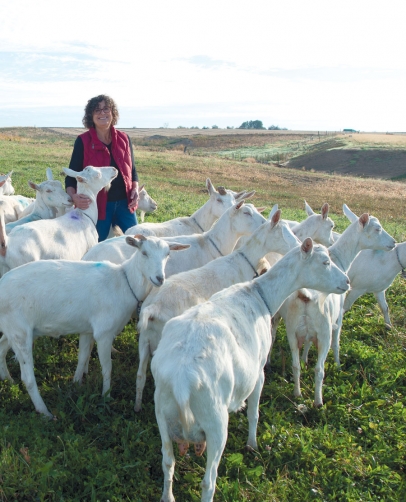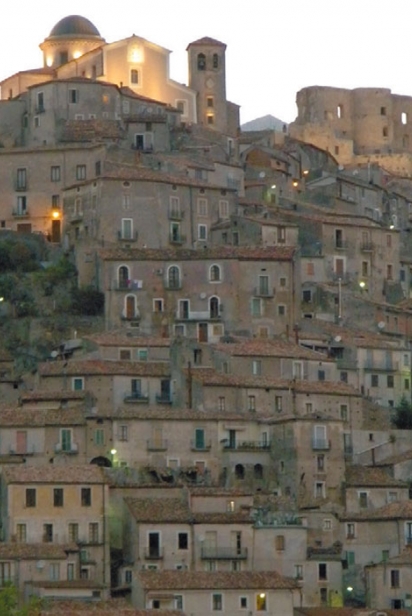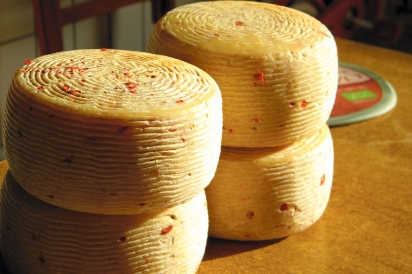From Italy to Idaho: Artisanal Cheesemaking in the Modern Era
I was served a surprisingly graphic example of Old World food culture on a research trip to Calabria, Italy. One afternoon, I found myself face to face with the cooked head of a sheep that my hosts Maria and Alfredo Barletta had placed on the table. As the sheep’s clouded eyes stared up at me, the Barlettas explained how to pick the meat off the skull with my fingers.
The Barletta family of Dolci Pascoli has lived on the same land in the small town of Morano Calabro in the southern region of Calabria for generations, raising sheep and goats for cheesemaking. Their 700-animal herd of mixed native breeds wanders the mountains to forage for food, protected by a pack of guard dogs and one shepherd. Animals that aren’t used for milking or breeding are butchered by the middle son, Alberto, and sold in town. Or they end up on the Barletta family table.
But I didn’t visit Italy merely for lunch; I was there to continue research for a project I’d begun in Idaho on small-scale cheesemakers. I wanted to find out some of the ways in which industrialized food processes have affected small-scale producers. I spent a year and a half at Rollingstone Chèvre in Parma, Idaho, and three months at Dolci Pascoli in Italy to complete my undergraduate anthropology honors thesis.
When initially planning my research, I tried to find artisanal producers that were at the opposite end of the spectrum from factory dairies making processed cheese. I envisioned early morning hand-milking, rows of cheeses aging in caves, rolling hills with foraging animals and small cheesemaking rooms where everything was done by hand. But what I experienced was much more nuanced—many small-scale producers have incorporated new processes and technologies into their centuries- old cheesemaking practices in an effort to improve their businesses. So while I sat on hay bales in the early hours of the morning and bottle-fed kids during my research, I also learned how to properly operate a pasteurizer.
The Barlettas are a prime example of the European artisans that America’s new breed of small-scale cheesemakers try to emulate. The cheeses they produce are all traditional Calabrian favorites: Pecorino di Morano (sheep cheese with dried peppers), il grutazzo (a raw aged goat cheese), caprino di Morano (goat cheese) and felciata (a soft raw cheese served in ferns). They also still use the miscu, a traditional wooden stirring stick, and keep traditional wood and reed tools for show.
But though their operation is idyllic in many ways, they have also adapted to contemporary production methods.
In 2000, feeling pressure to find a “modern” job to support his family, the youngest Barletta son, Giuseppe, decided to convert the family’s homestead lifestyle into a cheesemaking business. Giuseppe believes modern techniques don’t betray tradition, but rather improve the cheesemaking craft. Dolci Pascoli purchased new equipment that makes it easier to control temperatures while heating milk. They also invested in plastic molds, which are easier to keep sanitary than than the traditional reed ones, and purchased large walk-in refrigerators that control temperature and humidity better than the traditional caves.
One of the biggest additions to the Barletta’s cheesemaking operation is a pasteurizer. Though Italians aren’t required by law to pasteurize their milk (as is the case in the United States), some producers choose to pasteurize certain cheeses “to keep things clean,” explained Giuseppe. Other cheese varieties—like felciata and grutazzo—require the presence of naturally occurring regional bacteria to develop correctly, so the milk is left raw.
Dolci Pascoli is certified organic through the European Union. When I asked why, Giuseppe simply replied, “It’s never not been organic.” The family’s herd forages on a mountainous landscape hardly conducive to the application of chemical fertilizers, so there has never been a reason to pursue using them.
Prior to my work at Dolci Pascoli, I spent a year and a half with Karen Evans at Rollingstone Chèvre in Parma, Idaho. Karen and her late husband, Chuck, founded Rollingstone Chèvre 25 years ago. It was the first goat cheese operation in Idaho.
Because industrialization dominated the American food scene so completely in the mid-1900s, artisanal producers in the United States didn’t develop a complex, grassroots food culture like producers in Europe have had for centuries. So, like many small-scale American cheesemakers, the Evanses drew upon European traditions and recipes for inspiration.
However, Evans is quick to point out that, although Rollingstone’s cheeses have a distinct European flair, she considers them to be wholly American because they glean flavor and terroir from the Idaho landscape.
Rollingstone offers a wide range of cheeses: a soft, traditional French-style fromage blanc; a series of bloomy-rind cheeses named for the Snake River; a bleu; a jack; a banon-style Brandywine soaked in apple cider and brandy; and others that change with the seasons.
In the early years, Evans says Rollingstone Chèvre had to compete with the tastes of “Velveeta consumers,” or people who were unaccustomed to the varied textures and challenging flavors of European-style cheeses. Though many Americans have become more familiar with stronger cheeses in recent years, Rollingstone’s relatively mild fresh fromage blanc is still more popular than most of its aged cheeses.
With about 70 milkers at any one time, Evans’ operation is smaller yet more diverse than Dolci Pascoli’s. But American laws also limit the types of cheeses Rollingstone can produce. Evans says it’s illegal to sell raw-milk cheeses in the United States unless they’re aged for more than 60 days. Because of this requirement, Rollingstone’s cheeses are pasteurized, which Evans says prevents them from developing the same flavors as similarly produced European raw-milk cheeses.
“I can make the exact same style of cheese, do the process the same, and the cheese won’t taste as good,” said Evans.
Though Rollingstone Chèvre is focused on operating as naturally and humanely as possible, the business is not certified organic. Evans’ 45 acres of forage land are full of weeds and native plants not treated with fertilizers or pesticides. Evans says goats are natural foragers and are healthier if they’re eating out in a pasture. However, Evans also chooses to administer vaccines and some antibiotics to keep her goats healthy.
During my international cheesemaking adventure, I learned that the basic processes used to make cheese are the same in Italy as they are in Idaho. But I also discovered that every artisanal producer reacts to the industrial food system in his or her own way.
In a market flooded by factory cheese, small-scale artisans like Dolci Pascoli and Rollingstone Chèvre may honor a more pastoral model, but they also continually adjust the balance between tradition and technology. And that, I realized, is the nuanced reality of the modern artisanal food movement.







